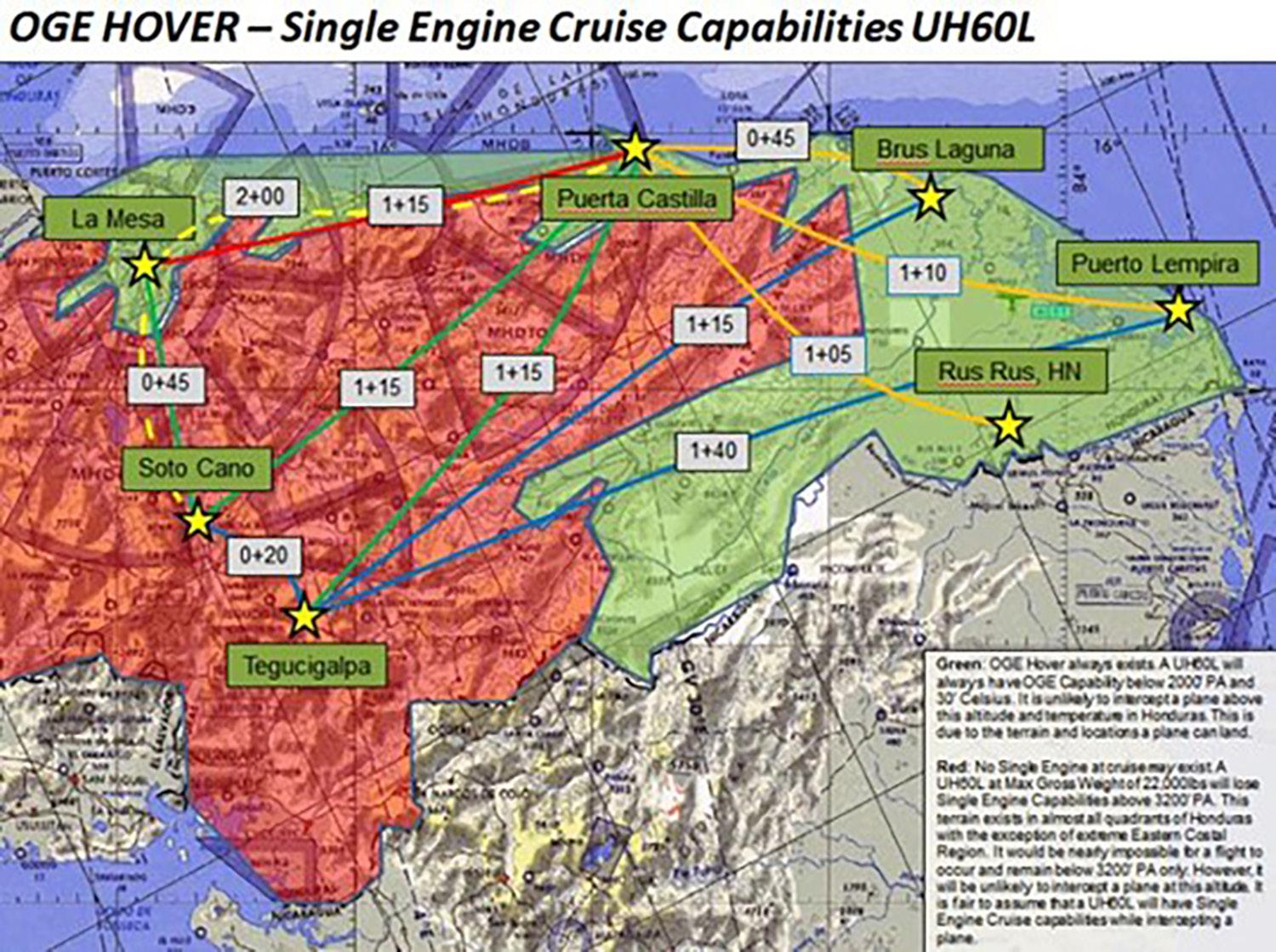Easyrider 30, Urgent SAR Required!
By LCDR Adam “NOFORN” Rollins, USN How an MH-60R crossed Central America to rescue 19 trapped Hondurans as a Category 5 Hurricane was hours from making landfall
A
s a new Officer-In-Charge (OIC) checking into HSM-37, I felt I had finally made it. For my entire career my family and I had wanted to be stationed in Hawaii, and I was lucky enough to be sent to the “Easyriders” of HSM-37 as a new Department Head. Within a few days of checking in, I learned that I would be taking Detachment 7 on deployment to the 4th Fleet AOR onboard USS William P. Lawrence (DDG 110) for a six-month counter-drug mission in the Caribbean Sea. With port calls every 10 days at a slew of exotic locales, this was going to be an epic deployment! WRONG. For this deployment, port calls were yet another casualty of the dreaded Coronavirus pandemic of 2020.
Single-Engine Cruise Capabilities for a UH-60L. Our route started in the lower left corner at the Gulf of Fonseca, and transited north to La Mesa.
Although we were disappointed we would not be allowed to leave the ship, we were still motivated to deploy when we learned we would be embarking a United States Coast Guard Law Enforcement Detachment (LEDET) and Precision Marksman-Airborne (PM-A) for the counterdrug mission. However, in the back of my mind, I knew we would be in Central America through the fall, which meant hurricane season. While we trained for the Airborne Use-of-Force (AUF) mission off of Kauai, I mentioned to our aircrews that humanitarian aid/disaster relief (HA/DR) missions were a very real possibility on this deployment, and to pack accordingly. Little did I know how true this statement would become.
By this time, our ship had already transited south through the Panama Canal, and was under TACON to the Joint Interagency Task Force-South (JIATF-S) and USCG District 11. However, just as we cleared the canal, we were informed that we were proceeding north along Central America’s Pacific Coast, and were directed to prepare our aircraft for humanitarian assistance. While it was still unclear exactly where we were going, we had about 36 hours to ready our aircraft and conduct mission planning. Finally, on Nov 11th, we were assigned a MODLOC on the EASTPAC side of Honduras, Nicaragua, and El Salvador in the vicinity of the Gulf of Fonseca. Joint Task Force-Bravo was requesting that our Detachment augment two U.S. Army UH-60L Blackhawks that were operating in the vast San Pedro Sula region of northwestern Honduras and flying around-theclock HADR and Search and Rescue missions.
Fast forward three months and 740 kilos of cocaine later, our detachment was pierside at Naval Station Guantanamo Bay in a “Liberty Haven,” drinking warm beer and swatting mosquitoes. Our Detachment Maintenance Officer, LT Austin Stack, came up to me and said, “Ya know Boss, there’s a pretty big storm heading towards Central America. They say it’s supposed to dump a lot of rain. Do you think we will be tasked for HADR ops?” With all my wisdom as a supersalty OIC, I said “No way. The storm doesn’t look that bad, and besides, we’re heading to EASTPAC anyway for more AUF missions.” Again…WRONG!
After a quick look at the charts available on our ship, it became immediately clear that this was not going to be an ordinary HADR mission. Between us and San Pedro Sula stood not just one, but two major mountain ranges with peaks over 9,000 feet tall. To make matters worse, all we had for mission planning was a low-altitude enroute chart and a terrain relief map of Central America. Luckily, a few of us had Fore Flight on our tablets and smartphones, which proved to be invaluable in the coming days. We immediately started planning a low-level route that could take us through both ranges, which led us to our next obstacle: fuel availability.
Hurricane Eta hit the Yucatan Peninsula on Nov 3rd, 2020 with torrential rainfall, causing landslides and destroying critical infrastructure such as bridges and powerlines, and killing at least 178 people in Central America. Eta hit with such force that even after weakening in Central America, it had enough strength left to deposit manatees on people’s front yards in Florida (seriously…it happened!).
Rotor Review #151 Winter '21
Our route from EASTPAC to San Pedro Sula was roughly 380 miles round trip. Even with auxiliary fuel tanks, our time on-station would have been minimal. Just as we were considering options for fuel in Honduras, we learned of an
42















